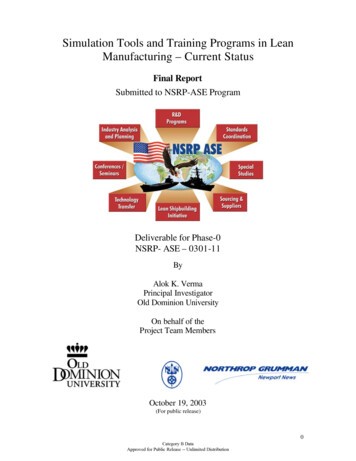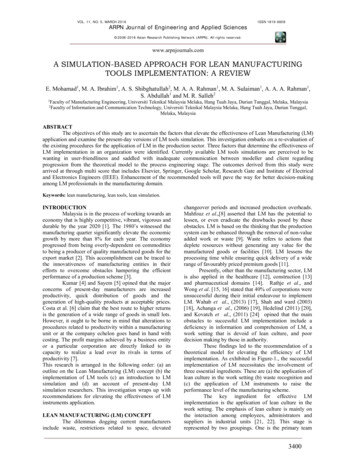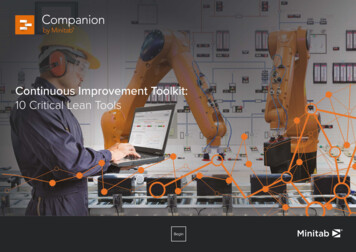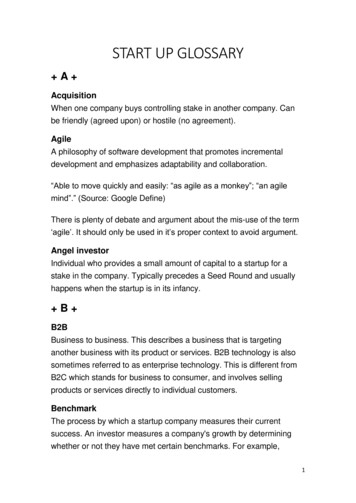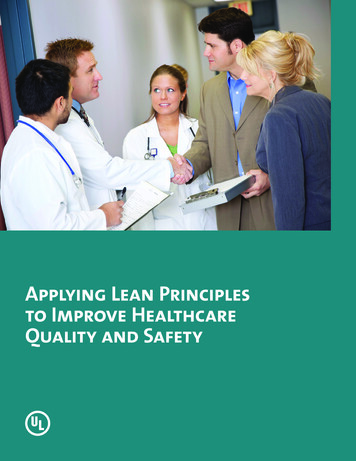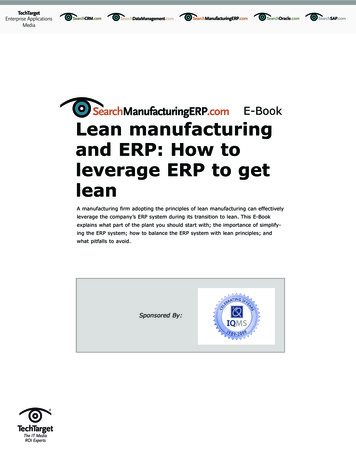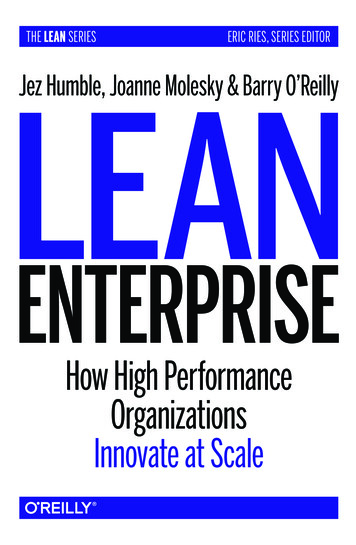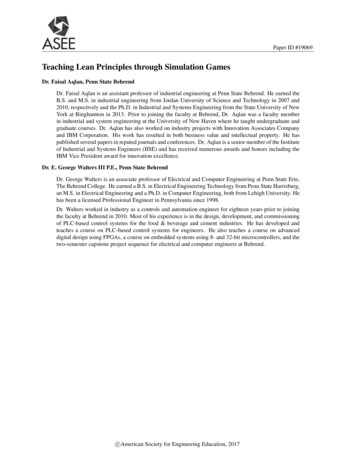
Transcription
Paper ID #19069Teaching Lean Principles through Simulation GamesDr. Faisal Aqlan, Penn State BehrendDr. Faisal Aqlan is an assistant professor of industrial engineering at Penn State Behrend. He earned theB.S. and M.S. in industrial engineering from Jordan University of Science and Technology in 2007 and2010, respectively and the Ph.D. in Industrial and Systems Engineering from the State University of NewYork at Binghamton in 2013. Prior to joining the faculty at Behrend, Dr. Aqlan was a faculty memberin industrial and system engineering at the University of New Haven where he taught undergraduate andgraduate courses. Dr. Aqlan has also worked on industry projects with Innovation Associates Companyand IBM Corporation. His work has resulted in both business value and intellectual property. He haspublished several papers in reputed journals and conferences. Dr. Aqlan is a senior member of the Instituteof Industrial and Systems Engineers (IISE) and has received numerous awards and honors including theIBM Vice President award for innovation excellence.Dr. E. George Walters III P.E., Penn State BehrendDr. George Walters is an associate professor of Electrical and Computer Engineering at Penn State Erie,The Behrend College. He earned a B.S. in Electrical Engineering Technology from Penn State Harrisburg,an M.S. in Electrical Engineering and a Ph.D. in Computer Engineering, both from Lehigh University. Hehas been a licensed Professional Engineer in Pennsylvania since 1998.Dr. Walters worked in industry as a controls and automation engineer for eighteen years prior to joiningthe faculty at Behrend in 2010. Most of his experience is in the design, development, and commissioningof PLC-based control systems for the food & beverage and cement industries. He has developed andteaches a course on PLC-based control systems for engineers. He also teaches a course on advanceddigital design using FPGAs, a course on embedded systems using 8- and 32-bit microcontrollers, and thetwo-semester capstone project sequence for electrical and computer engineers at Behrend.c American Society for Engineering Education, 2017
Teaching Lean Principles through Simulation GamesAbstractIn recent years, several training simulation games have been developed by academic and industryexperts to support the teaching and learning activities of Lean philosophy. Using simulationgames to teach Lean philosophy is an effective tool to convey the concepts to students. Thispaper discusses the teaching of Lean manufacturing principles to high school and undergraduatestudents through hands-on simulation experiments. Several Lean workshops and simulationgames are offered to the students. Lean workshops aim to teach students the basics of Leanmanufacturing as well as different Lean tools and techniques. Lean factory simulations include aset of hands-on experiments to teach students about manufacturing systems and Lean processimprovement. In addition, Lean projects are implemented by undergraduate students inpartnership with local industry. For each Lean activity, qualitative and quantitative data arecollected and analyzed to assess the outcomes of the simulations, projects, and workshops.IntroductionLean manufacturing is a continuous improvement approach that focuses on elimination of nonvalue added activities. The concept of Lean manufacturing was originated at Toyota MotorCompany. According to John Shook, Toyota’s first (and still only) American manager in Japan,Lean manufacturing is defined as “a manufacturing philosophy that shortens the time linebetween the customer order and the shipment by eliminating waste”1. There are eight types ofLean wastes: defects, over-production, waiting, non-utilized talent, transportation, inventory,motion, and extra-processing. The first letters of these eight wastes can be summarized in theword DOWNTIME. Table 1 shows the eight Lean wastes and their description.Table 1. Eight Lean wastesLean WasteDefectsOver-productionWaitingNon-utilized gDescriptionProducts to be reworked or scrappedProducing more or earlier than requiredAny non-work time waiting for tools, supplies, parts, etc.Not using or being aware of people’s talentUnnecessary movements of products and materialsExcess products or material not being processedUnnecessary movements by peopleMore work or higher quality than is required by customerActivities can be divided into three types: value added, non-value added, and non-value addedessential4. A description of these is given in Table 2. Process improvement projects should focuson emphasizing value added activities, minimizing essential non-value added activities, andeliminating non-value added activities. Reducing the amount of non-value add activities reducesthe production cost2.When waste in a process is reduced using Lean manufacturing, cost eventually will be dropped,since the process takes less time to produce the same or more. In other words, the process
becomes more efficient. This helps the company to maintain competitiveness over othercompanies in the market. Lean manufacturing also improves efficiency through reducinginventory, implementing a pull system and cellular manufacturing, reducing setup time, and byincreasing process flexibility3. This can be achieved by utilizing Lean tools and techniques.Table 2. Three main types of activitiesActivity TypeValue AddedNon-value AddedEssentialNon-value AddedDescriptiono Adds value to product or serviceo It is done right the first timeo Customer wants ito Does not add value to product or service and is necessaryfor the delivery of product or serviceo Does not add value to product or service and can betotally eliminatedActionEmphasizeMinimizeEliminate2. Lean Simulation GamesSeveral training simulation games have recently been developed by academic and industryexperts to support the teaching and learning activities of Lean philosophy. Using simulationgames to teach Lean philosophy is an effective tool to convey the concepts to students.Moreover, simulation games can effectively be used to teach the soft and hard skills forsuccessful Lean process improvement. A review study on simulation and games for teachingLean manufacturing found that 75% of the Lean simulations and games focus on productionlines. Other focus of the Lean simulations and games include enterprise-wide operations andnon-manufacturing industry5. Table 3 shows some examples of Lean simulations and games5.Table 3. Examples of Lean simulations and gamesName of Simulation/GameUK Paper Clip SimulationBuckingham Lean GameLean Enterprise Value SimulationLean Product Development Simulation5S Mini-Factory SimulationFurniture Factory SimulationShip Repair Design Process SimulationValue Stream Mapping Board GameLean Lego SimulationFocusManufacturingSupply ChainEnterpriseProduct DevelopmentManufacturingManufacturingDesign ProcessManufacturingManufacturingProductPaper FoldersNALego AircraftK’nex ProductTabletop Mini FactoriesWooden FurnitureContainer ShipBoard GameLego Cars3. Teaching Lean to High School and Undergraduate StudentsAt Penn State Behrend, Lean manufacturing workshops and simulation games are being offeredto both high school students and undergraduate students. The objective of these workshops andsimulation games is to provide the students with a practical understanding of Lean principles andprocess improvement methodologies. Several activities have been conducted over the last twoyears including workshops, simulation games, and practical projects with local industry. Table 4summarizes the different types of Lean activities and their descriptions.
Table 4. Lean activities and their descriptionsActivity Name Activity TypeExplorersEventWorkshopLean 101WorkshopActivity DescriptionProvides career exploration opportunitiesfor young people aged 14 and up.Teaches Lean concepts and tools toundergraduate engineering studentsLean FactorySimulation5S ectsTeaches Lean manufacturing toundergraduate byTeaches 5S methodology toundergraduate students byApply Lean to solve real life problems ina local companyLean Project inlocal industryTarget GroupHigh rgraduateIE StudentsUndergraduateIE StudentsUndergraduateIE StudentsThe Explorers Event is conducted every year in February and targets high school students. Theevent involves teaching the high school students Lean manufacturing concepts and it includeslectures and in-class activities. Students are also given tours to the different laboratories andparticipate in other laboratory experiments conducted on different topics including 3D printing,laser welding, etc. Figure 1 shows pictures from a recent Explorers Event.Figure 1. Lean number games workshop for high school studentsThe Lean 101 workshop is a 3-hour course offered to all Engineering students who are interestedin learning Lean manufacturing. The workshop is offered by the Institute of Industrial andSystems Engineers (IISE) Chapter at Penn State Behrend. The workshop is offered in the Springand Fall semesters. Most of the students who attend the workshop get internship positions andapply what they learn at the workshop in their internships. A survey was developed to gatherstudent feedback (if they already participated) and interest (if they have not) about the workshop.Student feedback on the workshop has been collected and analyzed. A sample survey is shown inTable 5, and survey results of the first seven questions are shown in Figure 2. The survey wasdistributed to 35 senior and junior students and 30 responses were received. From Figure 2, it isnoted that most students agree that workshop was effective and helped them to understand theLean concepts.
Table 5. Sample survey for the Lean 101 surveyNo.Q1Q9QuestionThe workshop helped me understand the Lean manufacturingconcepts and techniques.Information and/or skills presented were relevant and useful.The materials provided were useful.I can now apply Lean to real life process improvement cases.The hands-on activities were useful and effectively taught.The videos were helpful and informative.Do you recommend this workshop to other students?How would you rate the presenter’s knowledge of the subject?(please check one).How do you rate the overall quality of the presenter?Q10How would you rate the overall quality of this workshop?Q2Q3Q4Q5Q6Q7Q8Answer4 3 21NA444444111111NANANANANANA333333222222 Excellent Good Fair Poor Excellent Good Fair Poor Excellent Good Fair Poor4 Strongly Agree 3 Agree 2 Disagree 1 Strongly Disagree NA: Not Applicable302520151050Q1Q2Q3Q4432Q51Q6Q7NAFigure 2. Survey results for Lean 101 workshop (questions 1-7)For questions 8-10, most of the respondents rated the quality of the presenter and the course asexcellent (see Figure 3).
35302520151050Q8Q9ExcellentGoodQ10FairPoorFigure 3. Survey results for Lean 101 workshop (questions 8-10)Out of the 35 surveyed students who took the Lean 101 workshop, 19 indicated that they had aninternship during the summer. Of those 19 students, 16 had their internship in a manufacturingenvironment, and 15 students had an internship related to Lean manufacturing and/or processimprovement. Students who had an internship were asked to answer questions related to theworkshop (see Table 6).Table 6. Internship-related survey for the Lean 101 workshopNumber QuestionQ1The workshop was helpful and relevant to yourinternship.Q2Has the workshop inspired you to seek out aninternship?Q3The workshop helped me find an internship.Q4I anticipate career advancement as a result ofcompleting the internship.Q5I will prefer to get a job in Lean manufacturingand/or process improvement.4 Strongly Agree 3 Agree 2 Disagree 1 Strongly DisagreeAnswer4 321NA4321NA44332211NANA4321NANA: Not ApplicableThe survey results of the internship questions are shown in Figure 4. Most students think that theworkshop was helpful and relevant to their internships. Some students, however, have aninternship that is not related to process improvement and they don’t agree that the workshop wasrelevant to their internship. For question 2, most students who had no internships indicated thatthe workshop inspired them to seek one, while many students who already had internshipsanswered the question with “Disagree or Strongly Disagree”. Students also did not agree that theworkshop helped them to find an internship, especially those who already had one. However,
students prefer to find a job in Lean manufacturing and/or process improvement after theylearned about these topics in the workshop.181614121086420Q1Q2Q3432Q41Q5NAFigure 4. Survey results for questions related to internshipsThe last part of the survey includes 5 qualitative questions to gather student feedback on theworkshop. The five qualitative questions are:Q1: What skills did you learn that may help prepare you for working in industry?Q2: What did you like best or find most useful about the workshop?Q3: Things you did not like about the workshop.Q4: Suggestions for improving the workshop.Q5: Areas/topics about which you would like to receive further training.Students’ answers to the five questions, which are qualitative statements, were analyzed usingword clustering as shown in Figure 5. For question 1, students’ responses indicate that the skillsthey learned are Lean, Lean thinking, and Lean waste elimination. Responses to the secondquestion indicate that students like the Lean activities and videos. However, some students thinkthat the videos were long as indicated by the responses to question 3. Suggestions forimprovement include shortening the workshop or including short breaks and having moreactivities during the workshop. It should be noted that all the classes that the students are takingare only 50 minutes and the workshop is the first 3-hour long lecture they attend. This mayexplain why the students think the workshop was long. Students also would like to receive moreworkshops on Six Sigma as indicated by their response to question 5.The factory simulation experiments are designed to teach students the basics of manufacturingsystems. Four simulation experiments were conducted: Batch and Queue production, CellularFlow Push production, Cellular Flow Pull production, and Lean Flow production. The layouts ofthe Batch and Queue and the Lean Flow Productions experiments are shown in Figures 6 and 7,respectively. Table 7 shows sample results of the car factory simulations. It can be seen that theLean Flow has the highest values for profit and production rate. Simulation time was set to 10minutes.
Q1Q2Q3Q4Q5Figure 5. Word clustering for qualitative survey questionsTable 7. Sample results of the car factory simulationsSimulation ExperimentCost ItemRevenueSales ( 500/car)Total SalesRaw Material ( 100/car)Labor ( 165/worker)Costs of Goods SoldOvertime ( 40/minute)Overhead ( 10/chair)Scrap ( 100/car)Total Cost of Goods SoldWIP ( 60/car)Capital ChargeFacilities ( 15/Table)Facilities ( 10/Fixture)Total Capital ChargeSales – Costs of Goods Sold – Capital ChargesProduction Rate (car/minute)Batch and QueueNumber 189,000 9,000181,80069900.6525.655000 2,865.600690550 140 5,994.41.69Cellular Flow PushNumber 2412,000 12,000242,40069900066000 3,45000345220 65 8,4852.40Cellular Flow PullNumber 2613,000 13,000262,60069900055000 3,64000690330 120 9,2402.60Lean FlowNumber 2914,500 14,500292,90034950033000 3,42516023000 90 10,9852.90
Figure 6. Factory layout for batch production simulationFigure 7. Factory layout for Lean production simulation
The 5S simulation experiment involves two activities, Before and After, where students areasked to assemble a product. The Before activity, shown in Figure 8, involves studentsperforming an assembly of a plane where the parts and tools are randomly placed on the tables.Students were given two hours to finish the activity and they spent the first 40 minutes trying tofind the tools and parts used in the assembly process.Figure 8. Lean simulation game for 5S methodology (Before)
In the After activity, students implemented 5S to remove the parts and tools they don’t need andreorganize the workplace as shown in Figure 9. Students were able to complete the process with50% less time.Figure 9. Lean simulation game for 5S methodology (After)
Lean process improvement projects with local industry aim to provide students with hands-onexperience applying what they have learned in class to real life situations. The processimprovement projects were implemented at a company in the casting industry. Five differentprojects were selected and teams of four students were assigned to work on each project. Afterassigning the teams to the selected projects, each team worked on collecting data on the specificproblem and developed a clear problem statement and project objectives. Process improvementand Lean tools and techniques were used in the projects.Students used the concepts, tools, and techniques they learned through simulation games as wellas course lectures to solve the assigned problems. After completing the projects, students wereasked to provide their overall feedback on the industry project. Figure 10 shows the WordClustering for the student feedback. The most frequent words are “hands-on”, “experience”,“Lean”, “think”, “semester”, “time” “beginning”. From these words, we can conclude that thestudents “gained real life hands-on experience by implementing real-life projects which helpedthem think Lean”. Students also suggest that the selection and assignment of the projects shouldbe in the beginning of the semester because they think more time was needed to complete theprojects. This is because the projects were assigned in the third week of the semester due tologistics required to obtain the projects as well as develop the project plans and form the teams.In addition, the course instructor along with the industry partner needed to identify severalprojects and select the ones that fit the course content and benefit both the students and thecompany.Figure 10. Word clustering for student feedback on the industry project6. ConclusionsIn this study, we present several examples of teaching Lean manufacturing concepts throughsimulation games and real life industry projects. Qualitative and quantitative data were collectedand analyzed to measure the learning outcomes. Student feedback indicates that the simulationactivities are effective ways for understanding Lean concepts. Furthermore, the Leanmanufacturing projects allow students to gain hands-on experience and apply what they learn toreal life situations.
One of the main factors that the current Lean simulations and games do not consider is thecognitive skills and cultural aspects which are important for Lean manufacturing sustainability.In future work, we plan to integrate the cognitive and cultural factors into the Lean simulationgames. This will also require the development of assessment measures for the learning outcomes.References1. Liker, J.K., (1997) ‘Becoming Lean: Inside stories of U.S. manufacturers’, CRC Press.2. Tandon, P., Tiwari, A., Tamrakar, S., (2014) ‘Implementation of Lean manufacturingprinciples in foundries’, International Journal of Modern Engineering Research, Vol. 4, No.2., pp.1-5.3. Klier, T., (1993) ‘Lean manufacturing: understanding a new manufacturing system’, ChicagoField Letter, March, Vol. 67, pp.1–4, ABI/INFORM Global.4. Aqlan, F., Ashour, O., and Pedersen, A., (2016) ‘Lean process improvement of first casescheduling in operating rooms’, Proceedings of the 2016 International Conference onIndustrial Engineering and Operations Management, Detroit, MI, pp. 707-716.5. Badurdeen, F., Marksberry, P., Hall, A., and Gregorry, B., (2010) ‘Teaching Leanmanufacturing with simulations and games: A survey and future directions’, Simulations andGaming, Vol. 41, No. 4, pp. 465-486.
Lean workshops aim to teach students the basics of Lean manufacturing as well as different Lean tools and techniques. Lean factory simulations include a set of hands-on experiments to teach students about manufacturing systems and Lean process improvement. In addition, Lean



